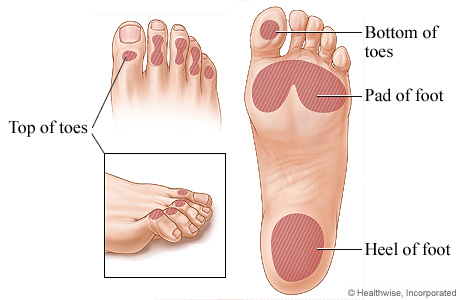Diabetic foot ulcer: Overview
Diabetes can damage the nerve endings and blood vessels in your feet. You're less likely to notice when your feet are injured. A small problem like a callus or blister can turn into a larger sore, called a foot ulcer. Foot ulcers form most often on the pad (ball) of the foot or the bottom of the big toe. You can also get them on the top and bottom of each toe.
Foot ulcers can get infected. If the infection is severe, then tissue in the foot can die (gangrene). Toes, part or all of the foot, and sometimes part of the leg may have to be removed (amputated).
Your doctor may have removed the dead tissue and cleaned the ulcer. Your foot may be wrapped in a bandage. It's important to keep your weight off your injured foot. A foot ulcer can't heal if you put weight on the area.
Always get early treatment for foot problems.
What are the symptoms of diabetic foot ulcers?
Symptoms include an open sore on the foot that is not healing or is healing slowly. The ulcer may have started as a callus, blister, or other foot injury. It may be swollen. It may smell bad and be reddish or purplish in color. It may or may not be painful.
Locations of foot ulcers

Diabetic foot ulcers usually occur on the bottom of the foot. They can also appear along the top and bottom of each toe. Shoes that do not fit well can cause ulcers on the sides of the feet.
Areas of the foot that have already had an ulcer may need more protection after healing, to prevent an ulcer from forming there again.
How are diabetic foot ulcers treated?
Treatment includes keeping your blood sugar levels in your target range. It also includes keeping weight off your injured foot. You may need a special boot. You may also need to use a cane, crutches, or a wheelchair. If the ulcer is infected, you may get antibiotics. The ulcer may be treated with surgery.
How are diabetic foot ulcers diagnosed?
Your doctor will do a foot exam and ask questions about your symptoms. You may be asked about the health of your feet, including past ulcers or other foot injuries. Your doctor may order tests.
How can you care for yourself when you have a diabetic foot ulcer?
- Follow your doctor's instructions about keeping pressure off the foot ulcer. You may need to use crutches or a wheelchair. Or you may wear a cast or a walking boot.
- Follow your doctor's instructions on how to clean the ulcer and change the bandage.
- If your doctor prescribed antibiotics, take them as directed. Do not stop taking them just because you feel better. You need to take the full course of antibiotics.
- Keep your blood sugar in your target range by watching what and how much you eat. Track your blood sugar, take medicines if prescribed, and get regular exercise.
- If you smoke, quit or cut back as much as you can. Smoking affects blood flow and can make foot problems worse. If you need help quitting, talk to your doctor about stop-smoking programs and medicines. These can increase your chances of quitting for good.
- Do not go barefoot. Protect your feet by wearing shoes that fit well. Choose shoes that are made of materials that are flexible and breathable, such as leather or cloth.
- Inspect your feet daily for blisters, cuts, cracks, or sores. If you can't see well, use a mirror or have someone help you.
- Have your doctor check your feet during each visit. If you have a foot problem, see your doctor. Do not try to treat your foot problem on your own. Home remedies or treatments that you can buy without a prescription (such as corn removers) can be harmful.
What is a diabetic foot ulcer?
A diabetic foot ulcer is an open sore on your foot that is caused by diabetes. An ulcer forms most often on the pad (ball) of the foot or the bottom of a big toe. Ulcers can also form on the sides of the foot, tops of the toes, or heel of the foot.
Diabetic foot ulcer: When to call
Call your doctor now or seek immediate medical care if:
- You have symptoms of infection, such as:
- Increased pain, swelling, warmth, or redness.
- Red streaks leading from the area.
- Pus draining from the area.
- A fever.
Watch closely for changes in your health, and be sure to contact your doctor if:
- You have a new problem with your feet, such as:
- A new sore or ulcer.
- A break in the skin that is not healing after several days.
- Bleeding corns or calluses.
- An ingrown toenail.
- You do not get better as expected.
©2011-2024 Healthwise, Incorporated